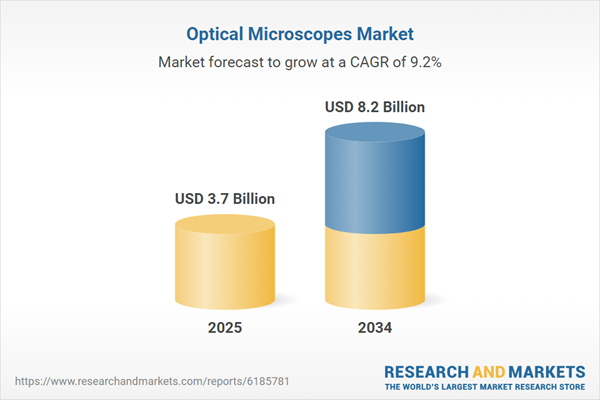The optical microscopes market is witnessing strong growth, driven by increasing applications in life sciences, material sciences, and industrial research. Optical microscopes, which use visible light and a series of lenses to magnify small objects, remain essential tools in academic research, healthcare diagnostics, and quality control processes. Technological advancements in fluorescence microscopy, phase-contrast imaging, and digital microscopy have enhanced image resolution, enabling more detailed visualization of cellular structures and materials. The demand for high-performance microscopes is increasing due to the expansion of nanotechnology, microbiology, and semiconductor industries, where precision imaging plays a crucial role. Additionally, the rising need for automated microscopy solutions, particularly in pathology and drug discovery, is driving market innovation. With continuous improvements in lens design, optical coatings, and imaging software, optical microscopes are becoming more versatile and efficient, further expanding their applications across scientific and industrial domains.
The optical microscopes market experienced notable advancements in AI-powered image analysis, super-resolution microscopy, and portable digital microscopy. AI-driven algorithms enhanced image processing, allowing automated identification of cellular structures and real-time diagnostic assistance in pathology and biomedical research. Super-resolution optical microscopes, capable of surpassing the diffraction limit of light, gained widespread adoption in molecular biology and neuroscience, enabling researchers to visualize nanoscale structures with unprecedented clarity. The demand for portable digital microscopes increased, particularly in educational institutions and remote healthcare settings, where cost-effective, high-resolution imaging solutions were required. The semiconductor industry also drove innovation in optical microscopy, with manufacturers integrating advanced inspection systems for defect analysis in microchips and nanomaterials. Meanwhile, sustainability initiatives encouraged the development of energy-efficient microscope components and environmentally friendly lens coatings, aligning with global efforts to reduce carbon footprints in scientific research and manufacturing.
The optical microscopes market is expected to evolve with innovations in 3D optical imaging, quantum-enhanced microscopy, and AI-driven autonomous microscopy systems. The development of 3D optical imaging will enable researchers to reconstruct highly detailed three-dimensional cellular and material structures, improving applications in regenerative medicine and biomaterials research. Quantum-enhanced microscopy, leveraging quantum entanglement for ultra-sensitive imaging, will provide new insights into biological processes at the molecular level. AI-powered autonomous microscopy systems will gain prominence in medical diagnostics, allowing real-time disease detection with minimal human intervention. The growing adoption of augmented reality (AR) and virtual reality (VR) in microscopy training and research will further transform how scientists and students interact with microscopic samples. Additionally, the miniaturization of high-resolution optical microscopes will enhance their portability, enabling widespread use in point-of-care diagnostics, field research, and industrial quality control. As microscopy continues to push the boundaries of resolution and imaging capabilities, the market will see sustained growth across scientific, medical, and industrial sectors.
Key Insights: Optical Microscopes Market
Advancements in Super-Resolution Optical Microscopy: The development of super-resolution microscopy techniques, such as stimulated emission depletion (STED) and structured illumination microscopy (SIM), is transforming biological research. These methods allow scientists to visualize nanoscale structures beyond the diffraction limit, offering higher clarity in cell biology, virology, and neuroimaging. Super-resolution microscopy is becoming indispensable in drug discovery and disease research, helping scientists understand cellular interactions at unprecedented detail. As technology evolves, improved image acquisition speed and real-time processing capabilities will drive broader adoption in medical and life sciences research.Integration of AI and Digital Microscopy: Artificial intelligence is revolutionizing optical microscopy by enabling automated image analysis, pattern recognition, and diagnostic support. AI-driven microscopy systems enhance workflow efficiency in pathology, microbiology, and materials science by reducing human errors and accelerating image interpretation. Digital microscopes equipped with AI-powered software can classify tissue samples, detect abnormalities, and generate quantitative reports with high precision. The increasing demand for AI-assisted diagnostic tools in healthcare is propelling the integration of deep learning models into microscopy workflows, improving accuracy and patient outcomes.
Growing Demand for Microscopy in Life Sciences and Healthcare: The expanding fields of biotechnology, genomics, and personalized medicine are driving the need for advanced optical microscopes in research and diagnostics. Optical imaging plays a critical role in detecting infectious diseases, analyzing genetic structures, and studying cellular mechanisms. The rising prevalence of chronic diseases and the need for precise histopathology analysis are further increasing demand for high-resolution microscopy solutions. With growing investments in medical research and drug development, the market for optical microscopes in life sciences continues to expand globally.
Increasing Adoption in Semiconductor and Nanotechnology Industries: Optical microscopes are essential in semiconductor manufacturing and nanotechnology research, where precision inspection and defect analysis are crucial. As microelectronics advance, the demand for high-magnification microscopes capable of detecting sub-micron defects in microchips and thin films is increasing. The rise of quantum computing, flexible electronics, and advanced nanomaterials is further driving investments in optical microscopy technologies. Manufacturers are continuously developing high-precision, automated microscopy systems to improve quality control processes in semiconductor fabrication and nanoengineering applications.
High Cost of Advanced Optical Microscopes: Despite technological advancements, the high cost of cutting-edge optical microscopes, including super-resolution and AI-integrated systems, remains a major challenge. Research institutions, healthcare providers, and small laboratories often face budget constraints in acquiring advanced imaging equipment. Additionally, maintenance and software upgrades add to operational expenses, limiting the accessibility of high-performance microscopy solutions in emerging markets. Developing cost-effective, scalable microscopy solutions will be essential for expanding market reach.
Optical Microscopes Market Segmentation
By Product
- Digital Microscopes
- Stereo Microscope
- Inverted Microscopes
- Other Products
By Application
- Aerospace
- Construction
- Power Industry
- Medical
- Other Applications
By End-User
- Hospitals and Clinics
- Academic and Research Institutes
- Diagnostics Laboratories
- Other End Users
Key Companies Analysed
- Thermo Fisher Scientific Inc.
- Danaher Corporation
- Carl Zeiss AG
- Agilent Technologies Inc.
- Keyence Corporation
- Olympus Corporation
- Hitachi High-Tech Corporation
- VWR International Inc.
- Sunny Optical Technology (Group) Company Limited
- Nikon Corporation
- Bruker Corporation
- Leica Microsystems GmbH
- Oxford Instruments plc
- Motic (Xiamen) Electric Group Co. Ltd
- Meiji Techno Co. Ltd.
- Celestron LLC
- Prior Scientific Instruments Ltd.
- Levenhuk Inc.
- Labomed Inc.
- Euromex Microscopen BV
- ACCU-SCOPE Inc.
- Hirox Co. Ltd.
- AmScope LLC
- Swift Optical Instruments
- Optec Instrumentation (Shanghai) Co. Ltd.
Optical Microscopes Market Analytics
The report employs rigorous tools, including Porter’s Five Forces, value chain mapping, and scenario-based modeling, to assess supply-demand dynamics. Cross-sector influences from parent, derived, and substitute markets are evaluated to identify risks and opportunities. Trade and pricing analytics provide an up-to-date view of international flows, including leading exporters, importers, and regional price trends.Macroeconomic indicators, policy frameworks such as carbon pricing and energy security strategies, and evolving consumer behavior are considered in forecasting scenarios. Recent deal flows, partnerships, and technology innovations are incorporated to assess their impact on future market performance.
Optical Microscopes Market Competitive Intelligence
The competitive landscape is mapped through proprietary frameworks, profiling leading companies with details on business models, product portfolios, financial performance, and strategic initiatives. Key developments such as mergers & acquisitions, technology collaborations, investment inflows, and regional expansions are analyzed for their competitive impact. The report also identifies emerging players and innovative startups contributing to market disruption.Regional insights highlight the most promising investment destinations, regulatory landscapes, and evolving partnerships across energy and industrial corridors.
Countries Covered
- North America - Optical Microscopes market data and outlook to 2034
- United States
- Canada
- Mexico
- Europe - Optical Microscopes market data and outlook to 2034
- Germany
- United Kingdom
- France
- Italy
- Spain
- BeNeLux
- Russia
- Sweden
- Asia-Pacific - Optical Microscopes market data and outlook to 2034
- China
- Japan
- India
- South Korea
- Australia
- Indonesia
- Malaysia
- Vietnam
- Middle East and Africa - Optical Microscopes market data and outlook to 2034
- Saudi Arabia
- South Africa
- Iran
- UAE
- Egypt
- South and Central America - Optical Microscopes market data and outlook to 2034
- Brazil
- Argentina
- Chile
- Peru
Research Methodology
This study combines primary inputs from industry experts across the Optical Microscopes value chain with secondary data from associations, government publications, trade databases, and company disclosures. Proprietary modeling techniques, including data triangulation, statistical correlation, and scenario planning, are applied to deliver reliable market sizing and forecasting.Key Questions Addressed
- What is the current and forecast market size of the Optical Microscopes industry at global, regional, and country levels?
- Which types, applications, and technologies present the highest growth potential?
- How are supply chains adapting to geopolitical and economic shocks?
- What role do policy frameworks, trade flows, and sustainability targets play in shaping demand?
- Who are the leading players, and how are their strategies evolving in the face of global uncertainty?
- Which regional “hotspots” and customer segments will outpace the market, and what go-to-market and partnership models best support entry and expansion?
- Where are the most investable opportunities - across technology roadmaps, sustainability-linked innovation, and M&A - and what is the best segment to invest over the next 3-5 years?
Your Key Takeaways from the Optical Microscopes Market Report
- Global Optical Microscopes market size and growth projections (CAGR), 2024-2034
- Impact of Russia-Ukraine, Israel-Palestine, and Hamas conflicts on Optical Microscopes trade, costs, and supply chains
- Optical Microscopes market size, share, and outlook across 5 regions and 27 countries, 2023-2034
- Optical Microscopes market size, CAGR, and market share of key products, applications, and end-user verticals, 2023-2034
- Short- and long-term Optical Microscopes market trends, drivers, restraints, and opportunities
- Porter’s Five Forces analysis, technological developments, and Optical Microscopes supply chain analysis
- Optical Microscopes trade analysis, Optical Microscopes market price analysis, and Optical Microscopes supply/demand dynamics
- Profiles of 5 leading companies - overview, key strategies, financials, and products
- Latest Optical Microscopes market news and developments
Additional Support
With the purchase of this report, you will receive:- An updated PDF report and an MS Excel data workbook containing all market tables and figures for easy analysis.
- 7-day post-sale analyst support for clarifications and in-scope supplementary data, ensuring the deliverable aligns precisely with your requirements.
- Complimentary report update to incorporate the latest available data and the impact of recent market developments.
This product will be delivered within 1-3 business days.
Table of Contents
Companies Mentioned
- Thermo Fisher Scientific Inc.
- Danaher Corporation
- Carl Zeiss AG
- Agilent Technologies Inc.
- Keyence Corporation
- Olympus Corporation
- Hitachi High-Tech Corporation
- VWR International Inc.
- Sunny Optical Technology (Group) Company Limited
- Nikon Corporation
- Bruker Corporation
- Leica Microsystems GmbH
- Oxford Instruments PLC
- Motic (Xiamen) Electric Group Co. Ltd.
- Meiji Techno Co. Ltd.
- Celestron LLC
- Prior Scientific Instruments Ltd.
- Levenhuk Inc.
- Labomed Inc.
- Euromex Microscopen BV
- ACCU-SCOPE Inc.
- Hirox Co. Ltd.
- AmScope LLC
- Swift Optical Instruments
- Optec Instrumentation (Shanghai) Co. Ltd.
Table Information
| Report Attribute | Details |
|---|---|
| No. of Pages | 160 |
| Published | October 2025 |
| Forecast Period | 2025 - 2034 |
| Estimated Market Value ( USD | $ 3.7 Billion |
| Forecasted Market Value ( USD | $ 8.2 Billion |
| Compound Annual Growth Rate | 9.2% |
| Regions Covered | Global |
| No. of Companies Mentioned | 25 |









